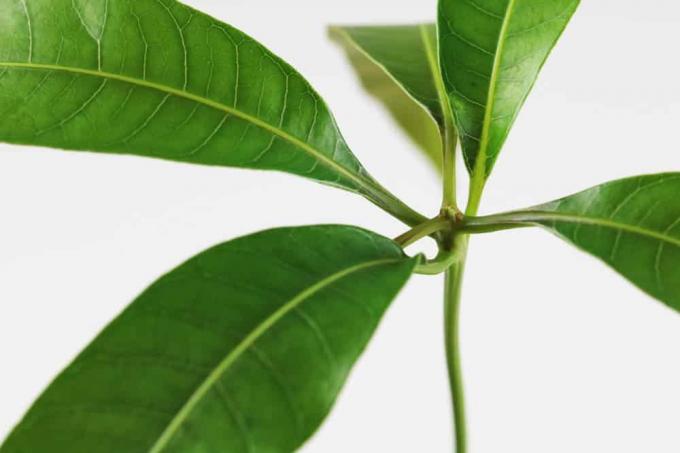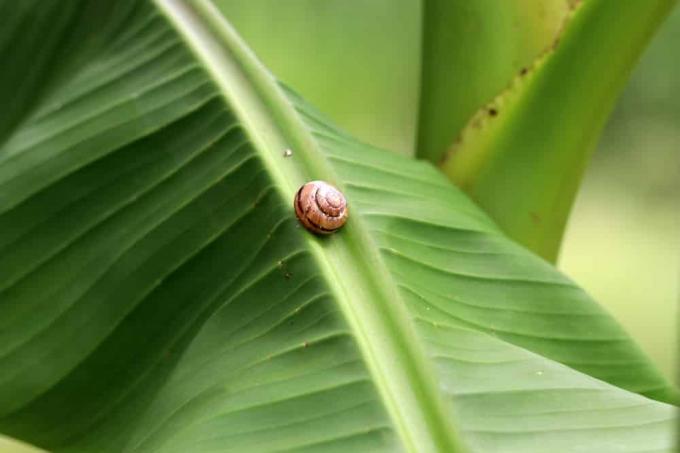

Table of contents
- Obtaining a suitable mango fruit or seed
- let the fruit ripen
- Separate the seed from the fruit
- Bring the seeds to germinate
- The right care
- Location
- fertilizing and watering
- repot
- fight disease
If you intend to grow a mango tree yourself, you need a very ripe or overripe mango fruit that has not yet started to rot. The riper the mango, the easier it is to remove the seed and the faster it will germinate. A ripe mango can be recognized by its leathery, wrinkled skin. The flesh of the fruit yields even under the slightest pressure. The fruit gives off a strong, sweet scent. Black dots are visible on their shell.
Obtaining a suitable mango fruit or seed
If you collect a mango directly from a fruit-bearing tree, it is an ideal seed donor. However, this opportunity is only available in very few cases. The easiest way is to buy a mango from the supermarket. But these fruits could have been treated with germ-inhibiting agents. In addition, the seed may have been damaged or dried up during the long journey that the mango has traveled. It is a bit safer to buy a mango from a greengrocer that is organic. Alternatively, a mango seed can also be bought from a seed dealer. But in many cases, growing a mango plant from a fruit seed works even if the fruit was bought the easiest way and comes from the supermarket around the corner.
let the fruit ripen

In a warm, sunny place, for example on the windowsill, the purchased mango will continue to ripen a little. Only when it shows all the signs of a truly ripe fruit should you start extracting the seed from it.
Separate the seed from the fruit
Special tools available from seed dealers can be used to extract the core from the mango. Alternatives are sharp scissors, a sharp knife or a screwdriver when removing semen. However, extreme caution is required in order not to injure your own hands or damage the seed core.
How to proceed:
- peel mango
- Roughly remove the flesh from the core with a knife
- Thoroughly clean the outer core of any pulp residue
- Carefully split the core with a sharp knife or a screwdriver at the tip or pry it open.
Tip:
If it doesn't work on the top side, just turn the core around and see if it's easier on the bottom side. The two shells of the outer hard core do not have to be completely separated. It is enough to open the core a bit. The soft, slightly kidney-shaped inner core is the actual seed.
- if the outer core is only opened, there is very little risk of damaging the seed, but the germination time is four to six weeks
- Alternatively, the outer core can be completely removed from the seed
- To do this, split the hard core completely or cut off the edges with sharp scissors and completely expose the seeds.
- It is essential to avoid damaging the inner core or the seed, otherwise its germination is uncertain.
- Finally, carefully remove any loose skins around the seed by hand
Tip:
The core is easier to split if it is dried before opening. To do this, it should be dried with a paper towel and then placed in a sunny and well-ventilated place. In addition, the riper the mango, the easier it is to open the core.
Bring the seeds to germinate

There are several ways to germinate the seed core extracted from the fruit. It can either be placed directly in loose potting soil, or you can let it germinate in a freezer bag or in a sealable Plexiglas jar. In the first variant, the germ appears after about four weeks. With the second variant, success can be visible after just a few days.
This is how you proceed when germinating in potting soil:
- Get a pot with drainage holes
- Create a loose substrate using peat, sand and coconut fibers or use ready-made potting soil
- Cover the bottom of the pot with potsherds or rocks to create a drainage hole that will allow water to drain properly
- Fill the pot with the prepared substrate
- stick the slightly open core upright in the substrate or stick the shelled seeds flat into the substrate and cover lightly with soil.
- Moisten the substrate well with low-lime water using a water spray bottle
- To maintain the humidity, the pot can then be covered with a transparent film, or the spraying can be repeated daily.
- Place the pot with the germ in a bright place where the temperature is between 24 and 30 degrees.
Tip:
To avoid mold and diseases, heat the potting soil to about 150 degrees in the oven before using it.
This is how you proceed when germinating in the freezer bag or in the Plexiglas box:
- Get paper kitchen towels and moisten them with low-calcium
- put seeds on it
- second layer of damp kitchen towels on top of the seeds
- alternatively, wrap seeds in a damp cotton cloth
- Place damp cloth or paper with seeds in a freezer bag or plexiglass jar
- Close the can or bag and place in a warm and bright place at about 24 degrees
- after a few days the longed-for germ can appear, which should then be placed in a pot to continue growing
The right care

With the right tricks, you can enjoy the plant for a long time and let it grow and thrive.
Location
In order to be able to grow and thrive well, the mango plant, like the germ, needs a bright and warm location. However, blazing sun should be avoided, as the young shoot could be burned by the sun. With age, the sensitivity of the plant decreases. If you want to put your mango tree in the garden, you can do so from the age of two. Then it can stand in a bucket outside in the summer and also in the sun. The plant can even tolerate slightly cooler temperatures. For a year-round room culture, a warm room with high humidity, such as the kitchen or bathroom, is recommended. If the mango tree has the ideal location, it is very easy to care for.
fertilizing and watering
In the first few weeks after germination, it does not need any additional nutrients. Although it requires high humidity around itself, it rarely needs to be watered or fertilized. Watering once a week is sufficient. The plant prefers water that is low in lime, such as rainwater or stagnant water. It is important to avoid waterlogging. However, the leaves like to be sprayed daily. The first time the plant should be fertilized at the earliest in the second month after sprouting, otherwise it will grow too quickly and weakly. The fertilization cycle can be four to eight weeks.
However, a gap of three weeks is better. The substrate can be renewed occasionally to keep the plant healthy. Since the plant does not take a winter break, the indoor culture must continue to be fertilized in winter. Commercial house plant fertilizer is recommended for use.
repot
Once the tree has reached a height of about 40 cm, the first pot change can take place. The plant does not need a cut. In the room, the young mango tree can easily winter in a bright and warm place. Outdoors, a mango tree only thrives in a warmer region, such as in south-west Germany or in wine-growing regions. It is therefore advisable to put the plant in a bucket in the garden and bring it in in winter.
If you still want to plant the tree directly in the garden soil, you should consider that it needs a lot of space because it can grow extremely high and its crown then develops very expansively. The roots also spread very much over the years, so that no other plants should be near the mango tree.
It is also advisable to put the mango tree in the garden after about two years or when a larger, healthy root ball has already developed. In the lower area, the trunk of the tree should have a diameter of at least five centimeters at this point. A sunny place is suitable as a location.
fight disease

In its original growth areas, the mango tree can be attacked by fungi and pests. This danger is especially present when the tree bears fruit. In our regions it hardly exists. Spider mites, on the other hand, can be noticed by withered or darkly discolored shoots. The shoot tips can even turn black. The mites are more common in dry and warm air. To prevent them, it helps to moisten the leaves of the mango plant with a spray bottle every day.
A shower or spraying with a hose can also prove to be particularly effective against the pests. In order to maintain the humid climate around the plant, it is advisable to cover it with transparent foil. The higher the humidity, the faster the spider mites die. If the mite infestation is severe, the plant should remain covered with the foil for about three days. It is then removed to repeat the treatment a week later. In this way you can prevent the mango plant from rotting under the film and also remove the next generation of pests at the same time.
 garden editorial
garden editorial I write about everything that interests me in my garden.
Learn more about Exotic Fruits

Mexican mini cucumber, Melothria scabra: Care from A – Z
The Mexican mini cucumber promises a refreshing treat for the palate in the summertime. As an annual climbing plant, the tropical pumpkin plant with yellow flowers is a pretty eye-catcher in the bed and on the balcony. The pretty Melothria scabra combines its exotic charm with modest demands. Read a tried-and-tested guide to care from A to Z here.

Lulo, Solanum quitoense: Care of the Quitorange from A to Z
Lulo, Solanum quitoense or Quitorange - the South American plant and its fruits are in this country almost unknown but have some advantages both as an ornamental plant and as a fruit-bearing shrub offer. All details from care to effect can be found here.

Growing watermelons: how to grow melons yourself
Watermelons are extremely heat-loving plants, but with a few tricks they can also be cultivated in the home regions and cultivated successfully. The site conditions and care play an important role. If these factors are right, the harvest of juicy melons will be plentiful.

Zierbanane, Musa Banana - care and instructions for wintering
With its majestic shape, the ornamental banana is a welcome guest in conservatories and imaginatively designed living spaces. The tropical Musa Banana looks gorgeous in a bucket on a summery balcony. This guide provides you with detailed information about the right care and provides well-founded instructions for overwintering the tropical beauty of plants.

Planting an avocado seed – this is how you grow an avocado tree
Avocados are already a delicacy in the local kitchen and it is hard to imagine life without them. But the plant is also becoming increasingly popular in the local latitudes in tubs as a houseplant. So if you still have seeds left after processing, you can plant them.

Growing Sharon fruit - how to grow persimmon plants from seed
The Sharon fruit, also known as the persimmon tree, is not yet widespread in the local latitudes. As a rule, the tree is cultivated here in a bucket because it is not hardy. The seeds of the fruit are now also being offered more and more frequently for your own cultivation.



